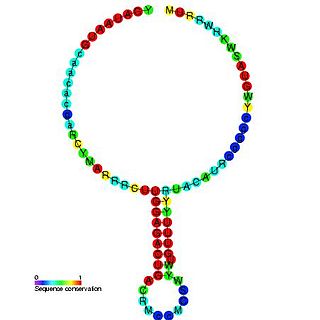
Christiane (Janni) Nüsslein-Volhard is a German developmental biologist and a 1995 Nobel Prize in Physiology or Medicine laureate. She is the only woman from Germany to have received a Nobel Prize in the sciences.
A genetic screen or mutagenesis screen is an experimental technique used to identify and select for individuals who possess a phenotype of interest in a mutagenized population. Hence a genetic screen is a type of phenotypic screen. Genetic screens can provide important information on gene function as well as the molecular events that underlie a biological process or pathway. While genome projects have identified an extensive inventory of genes in many different organisms, genetic screens can provide valuable insight as to how those genes function.

Drosophila embryogenesis, the process by which Drosophila embryos form, is a favorite model system for genetics and developmental biology. The study of its embryogenesis unlocked the century-long puzzle of how development was controlled, creating the field of evolutionary developmental biology. The small size, short generation time, and large brood size make it ideal for genetic studies. Transparent embryos facilitate developmental studies. Drosophila melanogaster was introduced into the field of genetic experiments by Thomas Hunt Morgan in 1909.
Segmentation in biology is the division of some animal and plant body plans into a series of repetitive segments. This article focuses on the segmentation of animal body plans, specifically using the examples of the taxa Arthropoda, Chordata, and Annelida. These three groups form segments by using a "growth zone" to direct and define the segments. While all three have a generally segmented body plan and use a growth zone, they use different mechanisms for generating this patterning. Even within these groups, different organisms have different mechanisms for segmenting the body. Segmentation of the body plan is important for allowing free movement and development of certain body parts. It also allows for regeneration in specific individuals.

Eric Francis Wieschaus is an American evolutionary developmental biologist and 1995 Nobel Prize-winner.

A morphogen is a substance whose non-uniform distribution governs the pattern of tissue development in the process of morphogenesis or pattern formation, one of the core processes of developmental biology, establishing positions of the various specialized cell types within a tissue. More specifically, a morphogen is a signaling molecule that acts directly on cells to produce specific cellular responses depending on its local concentration.
Hox genes, a subset of homeobox genes, are a group of related genes that specify regions of the body plan of an embryo along the head-tail axis of animals. Hox proteins encode and specify the characteristics of 'position', ensuring that the correct structures form in the correct places of the body. For example, Hox genes in insects specify which appendages form on a segment, and Hox genes in vertebrates specify the types and shape of vertebrae that will form. In segmented animals, Hox proteins thus confer segmental or positional identity, but do not form the actual segments themselves.

Krüppel is a gap gene in Drosophila melanogaster, located on the 2R chromosome, which encodes a zinc finger C2H2 transcription factor. Gap genes work together to establish the anterior-posterior segment patterning of the insect through regulation of the transcription factor encoding pair rule genes. These genes in turn regulate segment polarity genes. Krüppel means "cripple" in German, named for the crippled appearance of mutant larvae, who have failed to develop proper thoracic and anterior segments in the abdominal region. Mutants can also have abdominal mirror duplications.

A gap gene is a type of gene involved in the development of the segmented embryos of some arthropods. Gap genes are defined by the effect of a mutation in that gene, which causes the loss of contiguous body segments, resembling a gap in the normal body plan. Each gap gene, therefore, is necessary for the development of a section of the organism.
In the field of developmental biology, regional differentiation is the process by which different areas are identified in the development of the early embryo. The process by which the cells become specified differs between organisms.

The FIE3 element is an RNA element found in the 3′ UTR of the fushi tarazu mRNA. The fushi tarazu gene is essential for the establishment of the Drosophila embryonic body plan. When first expressed in early embryogenesis, fushi tarazu mRNA is uniformly distributed over most of the embryo. Subsequently, fushi tarazu mRNA expression rapidly evolves into a pattern of seven stripes that encircle the embryo. The instability of fushi tarazu mRNA may contribute to the localization of this pattern of expression, but this is unlikely to be a dominant effect since the 744 base-pair ftz zebra stripe element can drive the ectopic expression of a reporter construct in a qualitatively highly similar pattern. Experiments provide evidence for at least two destabilizing elements in the fushi tarazu mRNA, one located within the 5′ one-third of the mRNA and the other near the 3′ end. The FIE3 lies within a 201-nucleotide sequence just upstream of the polyadenylation signal and can act autonomously to destabilize a heterologous mRNA. Further deletion constructs identified an essential 68-nucleotide element within the FIE3. Although this element is predicted to contain a secondary structure, it also contains a GU rich sequence (UGUUUUGUUU) that is similar to GU rich instability elements subsequently identified in other systems.
A segmentation gene is a gene involved in the early stages of pattern formation that define repeated units (metameres) in a segmented organism, usually the embryo. They are classified into 3 groups: gap genes, pair-rule genes, and segment polarity genes. The expression of gap genes result in the formation of gaps in the normal pattern of structure in the embryo. Expression of pair-rule genes subdivides the embryo into a series of stripes and sets the boundaries of the parasegments. Segment polarity genes define the anterior and posterior polarities within each embryonic parasegment.
Patched (Ptc) is a conserved 12-pass transmembrane protein receptor that plays an obligate negative regulatory role in the Hedgehog signaling pathway in insects and vertebrates. Patched is an essential gene in embryogenesis for proper segmentation in the fly embryo, mutations in which may be embryonic lethal. Patched functions as the receptor for the Hedgehog protein and controls its spatial distribution, in part via endocytosis of bound Hedgehog protein, which is then targeted for lysosomal degradation.

Matthew P. Scott is an American biologist who was the tenth president of the Carnegie Institution for Science. While at Stanford University, Scott studied how embryonic and later development is governed by proteins that control gene activity and cell signaling processes. He independently discovered homeobox genes in Drosophila melanogaster working with Amy J. Weiner at Indiana University.
A segmentation gene is a generic term for a gene whose function is to specify tissue pattern in each repeated unit of a segmented organism. Animals are constructed of segments; however, Drosophila segments also contain subdivided compartments. There are five gene classes which each contribute to the segmentation and development of the embryonic drosophila. These five gene classes include the coordinate gene, gap gene, pair-rule gene, segment polarity gene, and homeotic gene. In embryonic drosophila, the pair-rule gene defines odd-skipped and even-skipped genes as parasegments, showing 7 stripes in the embryo. In the next gene class, segment polarity gene, individual segments each have their own anterior and posterior pole, resulting in 14 segments. In the fruit fly Drosophila melanogaster, segment polarity genes help to define the anterior and posterior polarities within each embryonic parasegment by regulating the transmission of signals via the Wnt signaling pathway and Hedgehog signaling pathway. Segment polarity genes are expressed in the embryo following expression of the gap genes and pair-rule genes. The most commonly cited examples of these genes are engrailed and gooseberry in Drosophila melanogaster. The segment polarity is the last step in embryonic development and a repeated pattern where each half of each segment is deleted and a mirror-image is duplicated and reversed to replace that half segment; thus, forming a pattern element.
Philip William Ingham FRS, FMedSci, Hon. FRCP is a British geneticist, currently the Toh Kian Chui Distinguished Professor at the Lee Kong Chian School of Medicine, a partnership between Nanyang Technological University, Singapore and Imperial College, London. Previously, he was the inaugural Director of the Living Systems Institute at the University of Exeter, UK and prior to that was Vice Dean, Research at the Lee Kong Chian School of Medicine.

Diethard Tautz is a German biologist and geneticist, who is primarily concerned with the molecular basis of the evolution of mammals. Since 2006 he is director at the Max Planck Institute for Evolutionary Biology in Plön.

Bicoid is a maternal effect gene whose protein concentration gradient patterns the anterior-posterior (A-P) axis during Drosophila embryogenesis. Bicoid was the first protein demonstrated to act as a morphogen. Although Bicoid is important for the development of Drosophila and other higher dipterans, it is absent from most other insects, where its role is accomplished by other genes.
Evx1 is a mammalian gene located downstream of the HoxA cluster, which encodes for a homeobox transcription factor. Evx1 is a homolog of even-skipped (eve), which is a pair-rule gene that regulates body segmentation in Drosophila. The expression of Evx1 is developmentally regulated, displaying a biphasic expression pattern with peak expression in the primitive streak during gastrulation and in interneurons during neural development. Evx1 has been shown to regulate anterior-posterior patterning during gastrulation by acting as a downstream effector of the Wnt and BMP signalling pathways. It is also a critical regulator of interneuron identity.

Spätzle or spaetzle is an evolutionarily-conserved arthropod protein first identified in Drosophila melanogaster. It plays a role in embryonic development and in the insect innate immune response. The name was coined by the Nobel laureate Christiane Nüsslein-Volhard after the Spätzle noodle-like form of homozygous mutant fly larvae.











